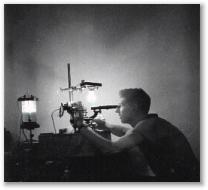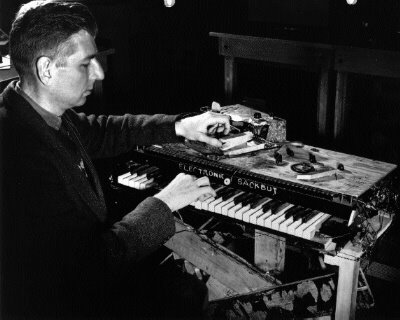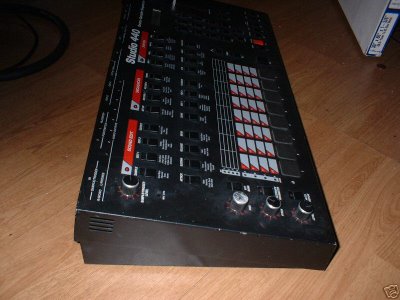
"The Polyphone (860004), an analogue polyphonic synthesizer, was built by Le Caine's National Research Council (NRC) lab in 1970, at the same time that the last two Sackbuts were being completed, and ten years before polyphonic synthesizers became commercially successful. Each key of its touch-sensitive keyboard had its own pitch control and wave form control. Essentially it was a bank of 37 key-operated oscillators, able to produce 37 separately defined tones.
Above the keyboard were several control devices that were typical of synthesizers at the time: low frequency oscillators, envelope generators, and filters, all of which could influence aspects of the overall sound produced by the instrument. Below the instrument was a pressure-sensitive pedal keyboard that controlled other aspects of the overall sound. The instrument provided extremely comprehensive resources and was potentially a very powerful tool; however, it was difficult to learn to play, a problem it shared with most synthesizers."
Title link takes you The Polyphone page on the
Canada Science and Technology Museum website. Make sure to check out some of the other interesting bits while there.

For more on Hugh Le Caine check out
Hugh Le Caine.com. The following was pulled from the biography:
"Canadian scientist and composer Hugh Le Caine (1914-1977) has been called one of the "heroes" of electronic music. He was brought up in Port Arthur (now Thunder Bay) in northwestern Ontario. At an early age he began building musical instruments and experimenting with electronic devices. In his youth he imagined "beautiful sounds" that he believed could be realized through new electronic inventions."
"At home he continued to pursue his interest in electronic music and sound generation. He established a personal studio in 1945, where he began to work independently on the design of electronic musical instruments such as the Electronic Sackbut, a sophisticated monophonic performance instrument now recognized as the first voltage-controlled synthesizer. Le Caine later developed voltage-control systems for a wide variety of applications."
"Perhaps the most important aspect of Le Caine's designs for his instruments was the "playability" that he took care to build into them. His fixation with "beautiful sound" led him repeatedly to design electronic instruments capable of producing a nuance-filled expression typical of the orchestral tradition. He had an acute sense of what performers needed if they were to be able to create the performance gestures that he believed formed the essence of music.
Touch sensitivity was an essential ingredient in this, and was used in keyboards, mixers, and other components, applied mechanically, electronically, and through light sensitivity. Le Caine's designs were so advanced in this respect that some of the features that he developed found their way into commercial designs only in the late 1980s."

Image of Le Caine with the Sackbut.
via Frederic.
Update via slabman in the comments: "He did some pretty amazing stuff with the technology of the day - some of it still unmatched. For example, the Sackbut has a touch sensitive 2D timbral mixer control that balances various overtones & waveforms. Made the sound very controllable & dynamic, but also made the instrument more difficult to master. It's interesting to think of how there's a kind of Bell curve of synthesizer technology: one one end you have the laboratory instrument type approach (Buchla, Serge); at the other end, you have people inventing new instruments like the Sackbut & Theremin. Commercial gear mostly occupies the bump in the middle of the curve. It would be great to see some more activity at that 'new instrument' end."
 Title link takes you to shots pulled from this auction.
Title link takes you to shots pulled from this auction. Title link takes you to shots pulled from this auction.
Title link takes you to shots pulled from this auction. "The Polyphone (860004), an analogue polyphonic synthesizer, was built by Le Caine's National Research Council (NRC) lab in 1970, at the same time that the last two Sackbuts were being completed, and ten years before polyphonic synthesizers became commercially successful. Each key of its touch-sensitive keyboard had its own pitch control and wave form control. Essentially it was a bank of 37 key-operated oscillators, able to produce 37 separately defined tones.
"The Polyphone (860004), an analogue polyphonic synthesizer, was built by Le Caine's National Research Council (NRC) lab in 1970, at the same time that the last two Sackbuts were being completed, and ten years before polyphonic synthesizers became commercially successful. Each key of its touch-sensitive keyboard had its own pitch control and wave form control. Essentially it was a bank of 37 key-operated oscillators, able to produce 37 separately defined tones. For more on Hugh Le Caine check out Hugh Le Caine.com. The following was pulled from the biography:
For more on Hugh Le Caine check out Hugh Le Caine.com. The following was pulled from the biography: Image of Le Caine with the Sackbut.
Image of Le Caine with the Sackbut. Title link takes you to shots pulled from this auction.
Title link takes you to shots pulled from this auction. Brian Comnes sent the following in after seeing this post on Women Take Back The Noise. The shots are of Blevin Blectum who is featured on the album.
Brian Comnes sent the following in after seeing this post on Women Take Back The Noise. The shots are of Blevin Blectum who is featured on the album. 
 rekem1000 sent me a greetings from Australia along with a link to his flickr set. Title link takes you there. There are some amazing shots in this set so do check it out. Thanks rekem1000! Man I love the color in this shot.
rekem1000 sent me a greetings from Australia along with a link to his flickr set. Title link takes you there. There are some amazing shots in this set so do check it out. Thanks rekem1000! Man I love the color in this shot.












